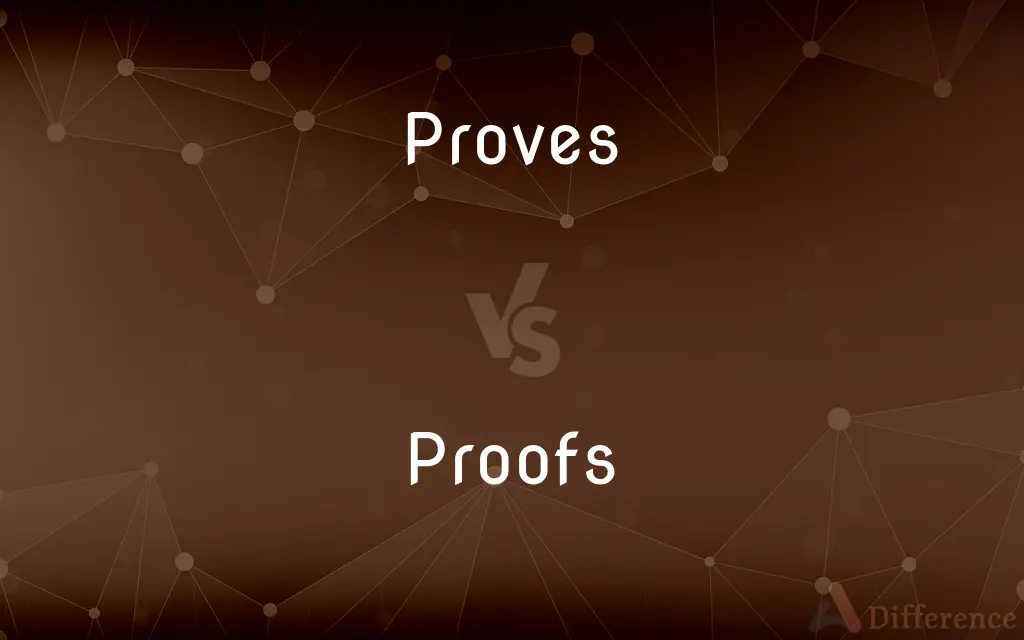Proves vs. Proofs — What's the Difference?
Edited by Tayyaba Rehman — By Urooj Arif — Updated on April 25, 2024
Proves is a verb meaning to establish the truth or existence of something, while proofs is the plural form of proof, referring to evidence or demonstration.

Difference Between Proves and Proofs
Table of Contents
ADVERTISEMENT
Key Differences
Proves is the third person singular present tense of the verb "prove," used to indicate the process of establishing the truth or validity of a statement or theory. Whereas proofs refers to the outcomes of such processes, denoting multiple instances or pieces of evidence that substantiate claims.
When someone proves something, they are actively engaging in an action to demonstrate that something is true, often through logical argumentation or empirical evidence. On the other hand, proofs are the results or documents that embody the evidence of what has been proven.
In legal or scientific contexts, proves is commonly used to describe the methodology or actions taken to verify facts or hypotheses. Whereas proofs are discussed as the tangible or concluded results that support the validated facts or theories.
In everyday language, "proves" often appears in discussions where ongoing validation is described, such as in experiments or debates. Conversely, proofs are typically mentioned in contexts like mathematics or printing, where they represent fixed sets of evidence or test prints.
In literature or argumentative writing, a writer might discuss how a character proves their loyalty or a theory proves its merit. Meanwhile, in academic or professional settings, references to proofs might involve discussing the proofs of a mathematical theorem or the proof copies of a book.
ADVERTISEMENT
Comparison Chart
Part of Speech
Verb
Noun
Usage Contexts
Describing actions of verification or demonstration
Referring to evidence or results of verification
Example Fields
Legal, scientific research
Mathematics, printing
Tense and Number
Third person singular present
Plural form
Typical Associations
Methodology, action
Documentation, outcomes
Compare with Definitions
Proves
Shows capability or worth.
The athlete proves her stamina in the marathon.
Proofs
Test prints in photography or printing.
The photographer examines the proofs before the final print.
Proves
Establishes validity in a legal context.
The attorney proves the innocence of the client.
Proofs
Logical arguments establishing a theorem in mathematics.
The mathematician explains the proofs of the theorem.
Proves
Verifies through testing or experimentation.
The scientist proves the new theory with extensive data.
Proofs
Finalized print materials before publication.
The editor reviews the proofs of the upcoming book.
Proves
Confirms authenticity or quality.
The jeweler proves the purity of the gold.
Proofs
Evidences supporting a claim or theory.
The detective gathers all proofs linking the suspect to the crime.
Proves
Demonstrates the truth through evidence.
The experiment proves the physicist's hypothesis correct.
Proofs
Trials or tests to determine quality.
The proofs of the new product convinced the company to begin mass production.
Proves
To establish the truth or validity of (something) by the presentation of argument or evidence
The novel proves that the essayist can write in more than one genre. The storm proved him to be wrong in his prediction.
Proofs
The evidence or argument that compels the mind to accept an assertion as true.
Proves
To demonstrate the reality of (something)
He proved his strength by doing 50 pushups.
Proofs
The validation of a proposition by application of specified rules, as of induction or deduction, to assumptions, axioms, and sequentially derived conclusions.
Proves
To show (oneself) to be what is specified or to have a certain characteristic
Proved herself to be a formidable debater.
Proved herself to be worthy of the task.
Proofs
A statement or argument used in such a validation.
Proves
To establish by the required amount of evidence
Proved his case in court.
Proofs
Convincing or persuasive demonstration
Was asked for proof of his identity.
An employment history that was proof of her dependability.
Proves
To establish the authenticity of (a will).
Proofs
The state of being convinced or persuaded by consideration of evidence.
Proves
To demonstrate the validity of (a hypothesis or proposition).
Proofs
Determination of the quality of something by testing; trial
Put one's beliefs to the proof.
Proves
To verify (the result of a calculation).
Proofs
The establishment of the truth or falsity of an allegation by evidence.
Proves
To subject (a gun, for instance) to a test.
Proofs
The evidence offered in support of or in contravention of an allegation.
Proves
(Printing) To make a sample impression of (type); proof.
Proofs
The alcoholic strength of a liquor, expressed by a number that is twice the percentage by volume of alcohol present.
Proves
(Archaic) To find out or learn (something) through experience.
Proofs
A trial sheet of printed material that is made to be checked and corrected. Also called proof sheet.
Proves
To be shown to be such; turn out
A theory that proved impractical in practice.
A schedule that proved to be too demanding.
Proofs
A trial impression of a plate, stone, or block taken at any of various stages in engraving.
Proves
Plural of prove
Proofs
A trial photographic print.
Proofs
Any of a limited number of newly minted coins or medals struck as specimens and for collectors from a new die on a polished planchet.
Proofs
(Archaic) Proven impenetrability
"I was clothed in Armor of proof" (John Bunyan).
Proofs
Fully or successfully resistant; impervious. Often used in combination
Waterproof watches.
A fireproof cellar door.
Proofs
Of standard alcoholic strength
Proof liquor.
Proofs
Used to proofread or correct typeset copy
A proof copy of the manuscript.
Proofs
To make a trial impression of (printed or engraved matter).
Proofs
To proofread (copy).
Proofs
To activate (dormant dry yeast) by adding water.
Proofs
To work (dough) into proper lightness.
Proofs
To treat so as to make resistant
Proof a fabric against shrinkage.
Proofs
(Printing) To proofread.
Proofs
To become properly light for cooking
The batter proofed overnight.
Proofs
Plural of proof.
Proofs
Samples of the copy and layout of a printed document for review by the author or a proofreader before mass printing.
Common Curiosities
Can "proves" and "proofs" be used interchangeably?
No, "proves" is a verb indicating the action of demonstrating truth, whereas "proofs" is a noun referring to the evidence or results of such demonstrations.
What examples of "proves" are common in scientific research?
In scientific research, "proves" is used when discussing the process of validating hypotheses through experiments and data analysis.
What is the difference in application between "proves" and "proofs" in mathematics?
In mathematics, the term "proves" is used to demonstrate the truth of a theorem, while "proofs" are the steps taken to achieve that demonstration.
What is the primary function of the verb "proves"?
The verb "proves" is used to demonstrate the truth or validity of something through evidence or logical argument.
Is "proves" used in everyday language?
Yes, "proves" is commonly used in everyday language to describe situations where someone or something demonstrates validity or effectiveness.
How is "proofs" typically used in academic contexts?
In academic contexts, "proofs" often refer to the logical arguments or sets of evidence that confirm the validity of a hypothesis or theory.
How do proofs function in the printing industry?
In the printing industry, proofs are preliminary versions of printed material used for review and approval before final production.
What does it mean when something "proves effective"?
When something "proves effective," it means it has been shown through results or testing to achieve the desired outcome successfully.
What types of proofs are involved in legal proceedings?
In legal proceedings, proofs include any evidence or documents that support or refute the claims made by the parties involved.
What is the purpose of proof in photography?
Photographers and printers often use test prints as a way to check the quality, colors, and exposure of an image before producing the final version.
Share Your Discovery

Previous Comparison
Tenant vs. Leaseholder
Next Comparison
Mature vs. RipeAuthor Spotlight
Written by
Urooj ArifUrooj is a skilled content writer at Ask Difference, known for her exceptional ability to simplify complex topics into engaging and informative content. With a passion for research and a flair for clear, concise writing, she consistently delivers articles that resonate with our diverse audience.
Edited by
Tayyaba RehmanTayyaba Rehman is a distinguished writer, currently serving as a primary contributor to askdifference.com. As a researcher in semantics and etymology, Tayyaba's passion for the complexity of languages and their distinctions has found a perfect home on the platform. Tayyaba delves into the intricacies of language, distinguishing between commonly confused words and phrases, thereby providing clarity for readers worldwide.















































